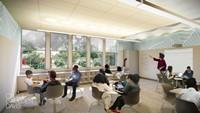The Impact of Biophilic Learning Spaces on Student Success

The purpose of this study is to examine to what extent the design of the physical learning space, enhanced with biophilic design, contributes to student stress reduction and improved learning outcomes for a middle school Math class at a public charter school in West Baltimore. The study presents findings of data collected from a biophilic classroom and a control classroom, where the physical design of each space varies—one is a traditional classroom while the biophilic classroom is enriched with views to nature, dynamic and diffuse daylight and biomorphic patterns. Data was collected by monitoring students’ HRV (heart rate variation) as a measure of stress, comparing academic performance, student surveys, and student and instructor interviews.
This study is the first research to investigate the impacts of a biophilic-enhanced learning space on learning outcomes for middle school mathematics students in an urban school. Through their responses in surveys, interviews and biometric testing, students in the biophilic classroom were less stressed than students in a control classroom. Through a series of diagnostic testing throughout the 2018-2019 academic year, the Math test scores of students in the biophilic classroom were more than 3 times better than those of students in the control classroom. In this study surveys, interviews, biometric testing, and cognitive tests all indicate the biophilic enhancements of the classroom are strongly associated with reduced student stress and enhanced learning outcomes.


Add comment
Log in to post comments